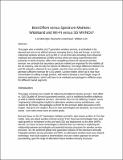| dc.description.abstract | This paper asks is whether (i) 3rd generation wireless services, as embodied in the
planned and soon to be offered services emerging first in Asia and Europe, or (ii) the
unlicensed wireless services such as 802.11 or wi-fi but also including more advanced
wideband and ultrawideband (UWB) services which are being experimented with
primarily in North America, offer more compelling visions for advanced wireless
services. we conclude that secondary spectrum markets are important for the viability of
the 3G industry, and not only for reasons of efficiency. One large difference between 2G
and 3G networks, observed in our models, was that voice services alone would not
generate sufficient revenues for a 3G system. License holders which up to now have
concentrated on selling a single product, will need to develop a much larger range of
advanced applications, which will have to be marketed and packaged in different ways
for different market segments. | en |
